药品质量标准USP
- 格式:ppt
- 大小:10.27 MB
- 文档页数:47

药典Pharmacopoeia是一个国家记载药品标准、规格的法典,一般由国家卫生行政部门主持编纂、颁布实施,国际性药典则由公认的国际组织或有关国家协商编订。
制定药品标准对加强药品质量的监督管理、保证质量、保障用药安全有效、维护人民健康起着十分重要的作用。
药品标准是药品现代化生产和质量管理的重要组成部分,是药品生产、供应、使用和监督管理部门共同遵循的法定依据。
药品质量的内涵包括三方面:真伪、纯度、品质优良度。
三者的集中表现是使用中的有效性和安全性。
因此,药品标准一般包括以下内容:法定名称、来源、性状、鉴别、纯度检查、含量(效价或活性)测定、类别、剂量、规格、贮藏、制剂等等。
药典是从本草学、药物学以及处方集的编著演化而来。
药典的重要特点是它的法定性和体例的规范化。
中国最早的药物典籍,比较公认的是公元659年唐代李□、苏敬等22人奉命编纂的《新修本草》。
全书54卷,收载药物844种,堪称世界上最早的一部法定药典。
15世纪印刷术的进步促进了欧洲近代药典编纂的发展。
许多国家都相继制订各自的药典。
1498年由佛罗伦萨学院出版的《佛罗伦萨处方集》,一般视为欧洲第一部法定药典。
其后有不少城市纷纷编订具有法律约束性的药典。
其中纽伦堡的瓦莱利乌斯医生编著的《药方书》赢得了很高的声誉,被纽伦堡当局承认,被定为第一本《纽伦堡药典》于1546年出版。
在《纽伦堡药典》的影响下,在奥格斯堡、安特卫普、里昂、巴塞尔、巴伦西亚、科隆、巴黎和阿姆斯特丹等地也相继有药典问世。
这一进展标志着欧洲各地区性药典向法定性国家药典转化的新阶段。
到20世纪90年代初,世界上至少已有38个国家编订了国家药典。
另外,尚有区域性药典3种及世界卫生组织(WHO)编订的《国际药典》。
下面简介几部著名药典。
英国药典(BP)自1864年第一版起,已出至第14版。
现行版为1988年版。
该药典从1980年版起改为两卷本。
第一卷收载绪论,通则和原料药品以及红外对照图谱等;第二卷收载各类药品制剂、血液制品、免疫制品、放射性药品、手术用品以及附录和索引等。

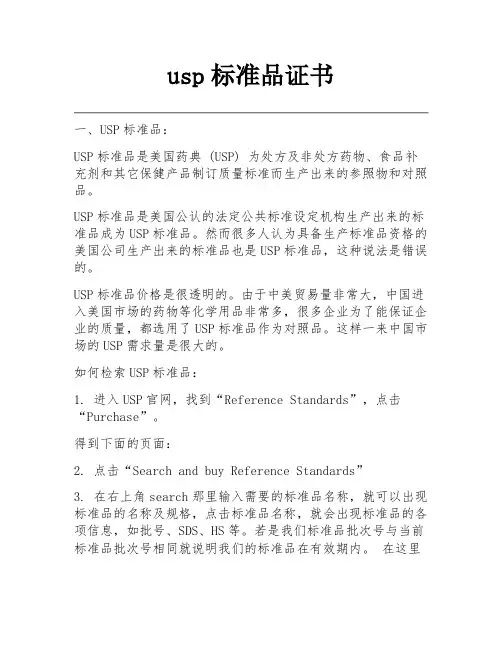
usp标准品证书一、USP标准品:USP标准品是美国药典 (USP) 为处方及非处方药物、食品补充剂和其它保健产品制订质量标准而生产出来的参照物和对照品。
USP标准品是美国公认的法定公共标准设定机构生产出来的标准品成为USP标准品。
然而很多人认为具备生产标准品资格的美国公司生产出来的标准品也是USP标准品,这种说法是错误的。
USP标准品价格是很透明的。
由于中美贸易量非常大,中国进入美国市场的药物等化学用品非常多,很多企业为了能保证企业的质量,都选用了USP标准品作为对照品。
这样一来中国市场的USP需求量是很大的。
如何检索USP标准品:1. 进入USP官网,找到“Reference Standards”,点击“Purchase”。
得到下面的页面:2. 点击“Search and buy Reference Standards”3. 在右上角search那里输入需要的标准品名称,就可以出现标准品的名称及规格,点击标准品名称,就会出现标准品的各项信息,如批号、SDS、HS等。
若是我们标准品批次号与当前标准品批次号相同就说明我们的标准品在有效期内。
在这里我们还能知道前些批次的有效使用日期,查看标准品USP证书等。
二、EP标准品EP标准品是欧盟国家药品质量检测的惟一指导标准品,所有药品和药用底物的生产厂家在欧洲范围内推销和使用的过程中,必须遵循EP的质量标准,EP标准品是生产中对产品进行检测是否符合欧盟标准的标准对照物质。
EP是欧洲药典的简称,标准品即标准物品,作为一种衡量标准,用做药物方面,则为含量测定中的标准含量。
生物制品标准物质系指用于生物制品效价、活性或含量测定的或其特性鉴别、检查的生物标准品或生物参考物质。
对照品系指用于鉴别、检查、含量测定和校正检定仪器性能的标准物质。
EP标准品是指以欧洲药典为准则的标准物质对照品。
EP标准品被广泛用在欧洲化工药物生物等生产,是欧洲化工等行业的不可缺少的物品,是欧洲化工行业质量的参考标准。
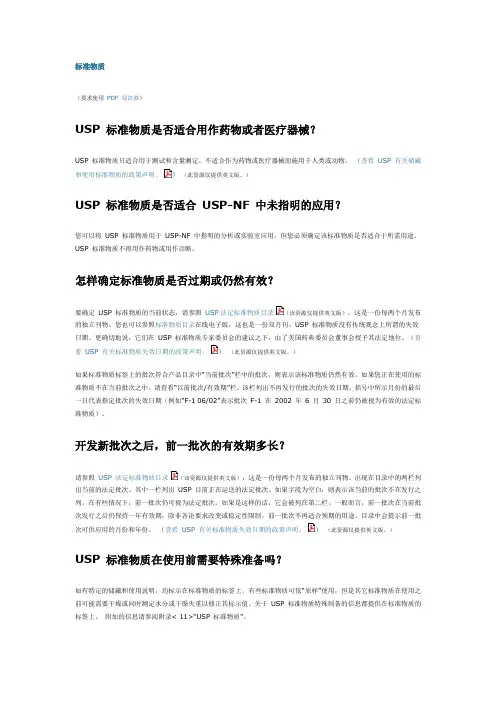
(要求使用PDF 阅读器)USP 标准物质是否适合用作药物或者医疗器械?USP 标准物质只适合用于测试和含量测定,不适合作为药物或医疗器械而施用于人类或动物。
(查看USP 有关储藏和使用标准物质的政策声明。
)(此资源仅提供英文版。
)USP 标准物质是否适合USP-NF 中未指明的应用?您可以将USP 标准物质用于USP-NF 中指明的分析或实验室应用,但您必须确定该标准物质是否适合于所需用途。
USP 标准物质不得用作药物或用作诊断。
怎样确定标准物质是否过期或仍然有效?要确定USP 标准物质的当前状态,请参照USP法定标准物质目录(该资源仅提供英文版),这是一份每两个月发布的独立刊物。
您也可以参照标准物质目录在线电子版,这也是一份双月刊。
USP 标准物质没有传统观念上所谓的失效日期。
更确切地说,它们在USP 标准物质专家委员会的建议之下,由了美国药典委员会董事会授予其法定地位。
(查看USP 有关标准物质失效日期的政策声明。
)(此资源仅提供英文版。
)如果标准物质标签上的批次符合产品目录中“当前批次”栏中的批次,则表示该标准物质仍然有效。
如果您正在使用的标准物质不在当前批次之中,请查看“以前批次/有效期”栏。
该栏列出不再发行的批次的失效日期。
括号中所示月份的最后一日代表指定批次的失效日期(例如“F-1 06/02”表示批次F-1 在2002 年6 月30 日之前仍被视为有效的法定标准物质)。
开发新批次之后,前一批次的有效期多长?请参照USP 法定标准物质目录(该资源仅提供英文版),这是一份每两个月发布的独立刊物。
出现在目录中的两栏列出当前的法定批次。
其中一栏列出USP 目前正在运送的法定批次。
如果字段为空白,则表示该当前的批次不在发行之列。
在有些情况下,前一批次仍可视为法定批次。
如果是这样的话,它会被列在第二栏。
一般而言,前一批次在当前批次发行之后仍保持一年有效期,除非各论要求改变或稳定性限制,前一批次不再适合预期的用途。
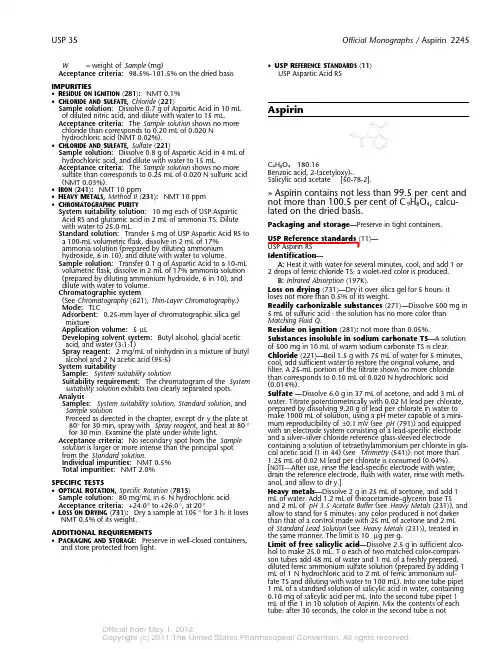
USP 35Official Monographs / Aspirin 2245W = weight of Sample (mg)•USP R EFERENCE S TANDARDS 〈11〉Acceptance criteria: 98.5%–101.5% on the dried basis USP Aspartic Acid RSIMPURITIES•R ESIDUE ON I GNITION 〈281〉: NMT 0.1%•C HLORIDE AND S ULFATE , Chloride 〈221〉Sample solution: Dissolve 0.7 g of Aspartic Acid in 10 mL Aspirinof diluted nitric acid, and dilute with water to 15 mL.Acceptance criteria: The Sample solution shows no more chloride than corresponds to 0.20 mL of 0.020 N hydrochloric acid (NMT 0.02%).•C HLORIDE AND S ULFATE , Sulfate 〈221〉Sample solution: Dissolve 0.8 g of Aspartic Acid in 4 mL of hydrochloric acid, and dilute with water to 15 mL.C 9H 8O 4180.16Acceptance criteria: The Sample solution shows no more Benzoic acid, 2-(acetyloxy)-.sulfate than corresponds to 0.25 mL of 0.020 N sulfuric acid Salicylic acid acetate [50-78-2].(NMT 0.03%).•I RON 〈241〉: NMT 10 ppm» Aspirin contains not less than 99.5 per cent and •H EAVY M ETALS , Method II 〈231〉: NMT 10 ppm not more than 100.5 per cent of C 9H 8O 4, calcu-•C HROMATOGRAPHIC P URITYSystem suitability solution: 10 mg each of USP Aspartic lated on the dried basis.Acid RS and glutamic acid in 2 mL of ammonia TS. Dilute Packaging and storage—Preserve in tight containers.with water to 25.0 mL.Standard solution: Transfer 5 mg of USP Aspartic Acid RS to USP Reference standards 〈11〉—a 100-mL volumetric flask, dissolve in 2 mL of 17%USP Aspirin RS ammonia solution (prepared by diluting ammonium Identification—hydroxide, 6 in 10), and dilute with water to volume.Sample solution: Transfer 0.1 g of Aspartic Acid to a 10-mL A: Heat it with water for several minutes, cool, and add 1 or volumetric flask, dissolve in 2 mL of 17% ammonia solution 2 drops of ferric chloride TS: a violet-red color is produced.(prepared by diluting ammonium hydroxide, 6 in 10), and B: Infrared Absorption 〈197K 〉.dilute with water to volume.Loss on drying 〈731〉—Dry it over silica gel for 5 hours: it Chromatographic systemloses not more than 0.5% of its weight.(See Chromatography 〈621〉, Thin-Layer Chromatography .)Readily carbonizable substances 〈271〉—Dissolve 500 mg in Mode: TLC5 mL of sulfuric acid : the solution has no more color than Adsorbent: 0.25-mm layer of chromatographic silica gel Matching Fluid Q.mixtureApplication volume: 5 µLResidue on ignition 〈281〉: not more than 0.05%.Developing solvent system: Butyl alcohol, glacial acetic Substances insoluble in sodium carbonate TS—A solution acid, and water (3:1:1)of 500 mg in 10 mL of warm sodium carbonate TS is clear.Spray reagent: 2 mg/mL of ninhydrin in a mixture of butyl Chloride 〈221〉—Boil 1.5 g with 75 mL of water for 5 minutes,alcohol and 2N acetic acid (95:5)cool, add sufficient water to restore the original volume, and System suitabilityfilter. A 25-mL portion of the filtrate shows no more chloride Sample: System suitability solutionthan corresponds to 0.10 mL of 0.020 N hydrochloric acid Suitability requirement: The chromatogram of the System (0.014%).suitability solution exhibits two clearly separated spots.Sulfate —Dissolve 6.0 g in 37 mL of acetone, and add 3 mL of Analysiswater. Titrate potentiometrically with 0.02 M lead per chlorate,Samples: System suitability solution , Standard solution , and prepared by dissolving 9.20 g of lead per chlorate in water to Sample solutionmake 1000 mL of solution, using a pH meter capable of a mini-Proceed as directed in the chapter, except dr y the plate at mum reproducibility of ±0.1 mV (see pH 〈791〉) and equipped 80° for 30 min, spray with Spray reagent , and heat at 80°with an electrode system consisting of a lead-specific electrode for 30 min. Examine the plate under white light.and a silver–silver chloride reference glass-sleeved electrodeAcceptance criteria: No secondar y spot from the Sample containing a solution of tetraethylammonium per chlorate in gla-solution is larger or more intense than the principal spot cial acetic acid (1 in 44) (see Titrimetry 〈541〉): not more than from the Standard solution .1.25 mL of 0.02 M lead per chlorate is consumed (0.04%).Individual impurities: NMT 0.5%[NOTE —After use, rinse the lead-specific electrode with water,Total impurities: NMT2.0%drain the reference electrode, flush with water, rinse with meth-anol, and allow to dr y.]SPECIFIC TESTS•O PTICAL R OTATION , Specific Rotation 〈781S 〉Heavy metals—Dissolve 2g in 25 mL of acetone, and add 1Sample solution: 80 mg/mL in 6N hydrochloric acid mL of water. Add 1.2 mL of thioacetamide–glycerin base TSAcceptance criteria: +24.0° to +26.0°, at 20°and 2 mL of pH 3.5 Acetate Buffer (see Heavy Metals 〈231〉), and •L OSS ON D RYING 〈731〉: Dry a sample at 105° for 3 h: it loses allow to stand for 5 minutes: any color produced is not darker NMT 0.5% of its weight.than that of a control made with 25 mL of acetone and 2 mL of Standard Lead Solution (see Heavy Metals 〈231〉), treated in ADDITIONAL REQUIREMENTSthe same manner. The limit is 10 µg per g.•P ACKAGING AND S TORAGE : Preserve in well-closed containers,Limit of free salicylic acid—Dissolve 2.5 g in sufficient alco-and store protected from light.hol to make 25.0 mL. T o each of two matched color-compari-son tubes add 48 mL of water and 1 mL of a freshly prepared,diluted ferric ammonium sulfate solution (prepared by adding 1mL of 1N hydrochloric acid to 2 mL of ferric ammonium sul-fate TS and diluting with water to 100 mL). Into one tube pipet 1 mL of a standard solution of salicylic acid in water, containing 0.10 mg of salicylic acid per mL. Into the second tube pipet 1mL of the 1 in 10 solution of Aspirin. Mix the contents of each tube: after 30 seconds, the color in the second tube is not2246Aspirin / Official MonographsUSP 35more intense than that in the tube containing the salicylic acid Standard preparation—Prepare a solution in Diluting solution (0.1%).having known concentrations of about 0.4 mg of USP Aspirin RS and 0.01 mg of USP Salicylic Acid RS per mL.Assay—Place about 1.5 g of Aspirin, accurately weighed, in a flask, add 50.0 mL of 0.5 N sodium hydroxide VS, and boil the Assay preparation—Weigh and finely powder not fewer than mixture gently for 10 minutes. Add phenolphthalein TS, and 10 Boluses. Transfer an accurately weighed portion of the pow-titrate the excess sodium hydroxide with 0.5 N sulfuric acid VS.der, equivalent to about 400 mg of aspirin, to a 100-mL volu-Perform a blank determination (see Residual Titrations under Ti-metric flask, dilute with Diluting solution to volume, and stir by trimetry 〈541〉). Each mL of 0.5 N sodium hydroxide is equiva-mechanical means for about 15 minutes. Pass a portion of this lent to 45.04 mg of C 9H 8O 4.solution through a filter having a 0.5-µm or finer porosity, and use the filtrate as the Assay preparation .Chromatographic system (see Chromatography 〈621〉)—The liquid chromatograph is equipped with a 254-nm detector and a 4.6-mm × 25-cm column that contains 5-µm packing L1. The Aspirin Bolusesflow rate is about 1 mL per minute. Chromatograph the Stan-dard preparation , and record the peak responses as directed for » Aspirin Boluses contain not less than 90.0 per-Procedure: the relative retention times are about 0.6 for salicylic acid and 1.0 for aspirin, and the relative standard deviation of cent and not more than 110.0 per cent of the the aspirin peak response for replicate injections is not more labeled amount of aspirin (C 9H 8O 4).than 2.0%.Packaging and storage—Preserve in tight containers.Procedure—Separately inject equal volumes (about 20 µL) of the Standard preparation and the Assay preparation into the Labeling—Label Boluses to indicate that they are for veterinar y chromatograph, record the chromatograms, and measure the use only.responses for the major peaks. Calculate the quantity, in mg, of USP Reference standards 〈11〉—aspirin (C 9H 8O 4) in the portion of Boluses taken by the formula:USP Aspirin RS1000C (r U /r S )USP Salicylic Acid RS Identification—in which C is the concentration, in mg per mL, of USP Aspirin A: Crush 1 Bolus, boil a portion of the powder, equivalent to RS in the Standard preparation; and r U and r S are the aspirin about 300 mg of aspirin, with 50 mL of water, cool, and add a peak responses obtained from the Assay preparation and the drop of ferric chloride TS: a violet-red color is produced.Standard preparation, respectively.B: The retention time of the aspirin peak in the chromato-gram of the Assay preparation corresponds to that in the chro-matogram of the Standard preparation, as obtained in the Assay .Dissolution 〈711〉—Aspirin CapsulesMedium: 0.5 M phosphate buffer, pH 7.4; 900 mL.Apparatus 2: 75 rpm.» Aspirin Capsules contain not less than 93.0 per-Time: 45 minutes.cent and not more than 107.0 per cent of the Diluting solution—Prepare a mixture of acetonitrile and for-labeled amount of aspirin (C 9H 8O 4).mic acid (99:1).NOTE —Capsules that are enteric-coated or the Procedure—Determine the amount of aspirin (C 9H 8O 4) dis-contents of which are enteric-coated meet the solved by employing UV absorption at the wavelength of the isosbestic point of aspirin and salicylic acid at 265±2 nm on requirements for Aspirin Delayed-Release Capsules .filtered portions of the solution under test, suitably diluted with Packaging and storage—Preserve in tight containers.Diluting solution, if necessar y, in comparison with a Standard solution having a known concentration of USP Aspirin RS in the USP Reference standards 〈11〉—same Medium . [NOTE —Prepare the Standard solution at the time USP Aspirin RS of use.]Identification—Tolerances—Not less than 80% (Q) of the labeled amount of C 9H 8O 4 is dissolved in 45 minutes.A: Heat about 100 mg of the Capsule contents with 10 mL of water for several minutes, cool, and add 1 drop of ferric Uniformity of dosage units 〈905〉: meet the requirements.chloride TS: a violet-red color is produced.Limit of salicylic acid—Using the chromatograms of the B: Shake a quantity of the contents of Capsules, equivalent Standard preparation and the Assay preparation, obtained as di-to about 500 mg of aspirin, with 10 mL of alcohol for several rected in the Assay, calculate the per centage of salicylic acid minutes. Centrifuge the mixture. Pour off the clear supernatant (C 7H 6O 3) in the portion of Boluses taken by the formula:and evaporate it to dr yness. Dry the residue in vacuum at 60°for 1 hour: the residue responds to Identification test B under 100,000(C /W A )(r U /r S )Aspirin .in which C is the concentration, in mg per mL, of USP Salicylic Dissolution 〈711〉—Acid RS in the Standard preparation; W A is the quantity, in mg,Medium: 0.05 M acetate buffer, prepared by mixing 2.99of aspirin (C 9H 8O 4) in the portion of Boluses taken, as deter-g of sodium acetate trihydrate and 1.66 mL of glacial acetic mined in the Assay; and r U and r S are the salicylic acid peakacid with water to obtain 1000 mL of solution having a pH of responses obtained from the Assay preparation and the Standard 4.50 ± 0.05; 500 mL.preparation, respectively: not more than 0.3% is found.Apparatus 1: 100 rpm.Assay—Time: 30 minutes.Mobile phase—Dissolve 2g of sodium 1-heptanesulfonate in Procedure—Determine the amount of C 9H 8O 4 dissolved from a mixture of 850 mL of water and 150 mL of acetonitrile, and UV absorbances at the wavelength of the isosbestic point of adjust with glacial acetic acid to a pH of 3.4. Make any neces-aspirin and salicylic acid at 265±2 nm of filtered portions of sary adjustments (see System Suitability under Chromatography the solution under test, suitably diluted with Medium, if neces-〈621〉).sary, in comparison with a Standard solution having a known Diluting solution—Prepare a mixture of acetonitrile and for-concentration of USP Aspirin RS in the same Medium. [NOTE —mic acid (99:1).。

usp38纯化水标准USP38纯化水标准。
USP38纯化水标准是指美国药典第38版中对于纯化水质量的规定和要求。
纯化水是制药工业中常用的一种水质,它需要符合一定的纯度和质量标准,以确保药品的生产质量和安全性。
USP38纯化水标准作为国际上公认的药品质量标准,对于纯化水的生产、储存和使用都有着明确的规定。
根据USP38纯化水标准,纯化水应当符合一定的物理、化学和微生物指标。
首先,物理指标包括水的外观、颜色、浑浊度等方面的要求。
纯化水应当呈无色透明的状态,不应当有任何悬浮物质或沉淀物。
其次,化学指标包括电导率、溶解固体、氧化还原电位等方面的要求。
纯化水应当具有较低的电导率和溶解固体含量,且应当保持中性或接近中性的氧化还原电位。
最后,微生物指标要求纯化水应当符合一定的微生物限度,不应当含有致病菌或其他有害微生物。
除了物理、化学和微生物指标外,USP38纯化水标准还对纯化水的生产和质量控制提出了要求。
生产纯化水的设备和工艺应当符合GMP要求,并且需要进行定期的验证和监控。
对于纯化水的储存和分配也有着明确的规定,包括储存容器的材质、清洁消毒程序、标识和记录等方面的要求。
此外,纯化水的使用也需要符合一定的规定,包括使用前的检查验证、管路系统的清洁消毒、使用记录和回收处理等方面的要求。
总的来说,USP38纯化水标准对于纯化水的质量和生产管理提出了严格的要求,这些要求旨在确保纯化水的质量稳定和安全可靠。
作为制药行业的重要辅助物质,纯化水的质量直接关系到药品的质量和安全性,因此严格遵守USP38纯化水标准是制药企业的基本要求。
在实际生产中,制药企业需要建立完善的纯化水生产管理体系,包括严格的生产工艺、设备验证、质量控制和记录管理等方面的要求。
同时,制药企业还需要加强对纯化水生产和使用过程中的风险评估和控制,确保纯化水的质量和安全性。
只有这样,才能确保纯化水符合USP38标准的要求,为药品的生产提供可靠的保障。
总之,USP38纯化水标准是制药行业对于纯化水质量的严格规定,其要求涵盖了纯化水的物理、化学和微生物指标,以及生产、储存和使用方面的要求。
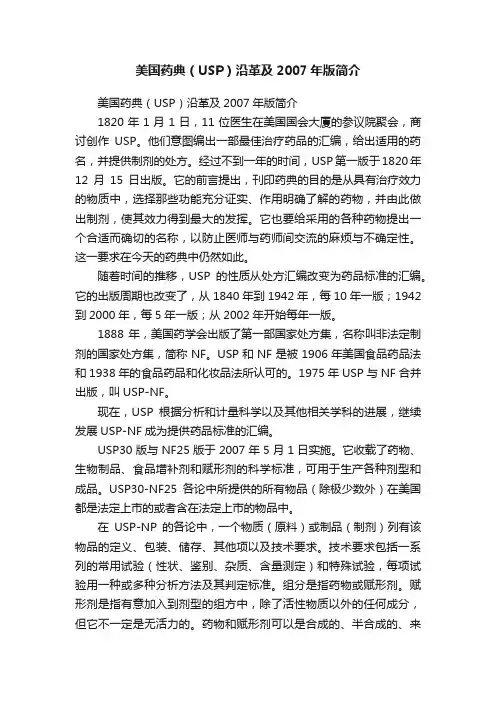
美国药典(USP)沿革及2007年版简介美国药典(USP)沿革及2007年版简介1820年1月1日,11位医生在美国国会大厦的参议院聚会,商讨创作USP。
他们意图编出一部最佳治疗药品的汇编,给出适用的药名,并提供制剂的处方。
经过不到一年的时间,USP第一版于1820年12月15日出版。
它的前言提出,刊印药典的目的是从具有治疗效力的物质中,选择那些功能充分证实、作用明确了解的药物,并由此做出制剂,使其效力得到最大的发挥。
它也要给采用的各种药物提出一个合适而确切的名称,以防止医师与药师间交流的麻烦与不确定性。
这一要求在今天的药典中仍然如此。
随着时间的推移,USP的性质从处方汇编改变为药品标准的汇编。
它的出版周期也改变了,从1840年到1942年,每10年一版;1942到2000年,每5年一版;从2002年开始每年一版。
1888年,美国药学会出版了第一部国家处方集,名称叫非法定制剂的国家处方集,简称NF。
USP和NF是被1906年美国食品药品法和1938年的食品药品和化妆品法所认可的。
1975年USP与NF合并出版,叫USP-NF。
现在,USP根据分析和计量科学以及其他相关学科的进展,继续发展USP-NF成为提供药品标准的汇编。
USP30版与NF25版于2007年5月1日实施。
它收载了药物、生物制品、食品增补剂和赋形剂的科学标准,可用于生产各种剂型和成品。
USP30-NF25各论中所提供的所有物品(除极少数外)在美国都是法定上市的或者含在法定上市的物品中。
在USP-NP的各论中,一个物质(原料)或制品(制剂)列有该物品的定义、包装、储存、其他项以及技术要求。
技术要求包括一系列的常用试验(性状、鉴别、杂质、含量测定)和特殊试验,每项试验用一种或多种分析方法及其判定标准。
组分是指药物或赋形剂。
赋形剂是指有意加入到剂型的组方中,除了活性物质以外的任何成分,但它不一定是无活力的。
药物和赋形剂可以是合成的、半合成的、来自自然界的或用重组技术生产的。
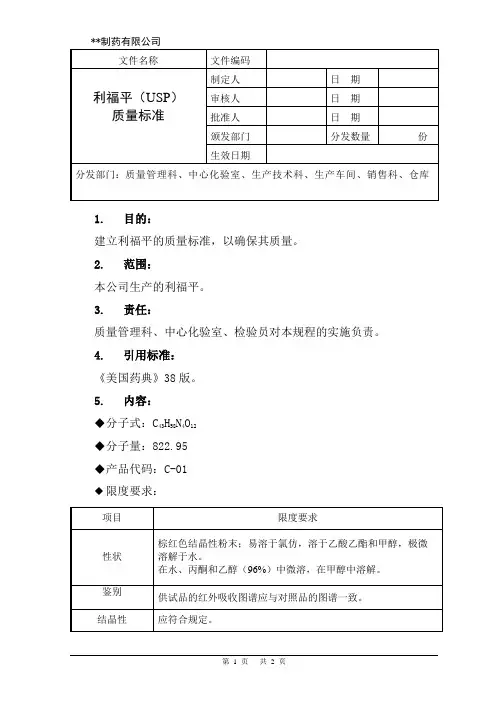
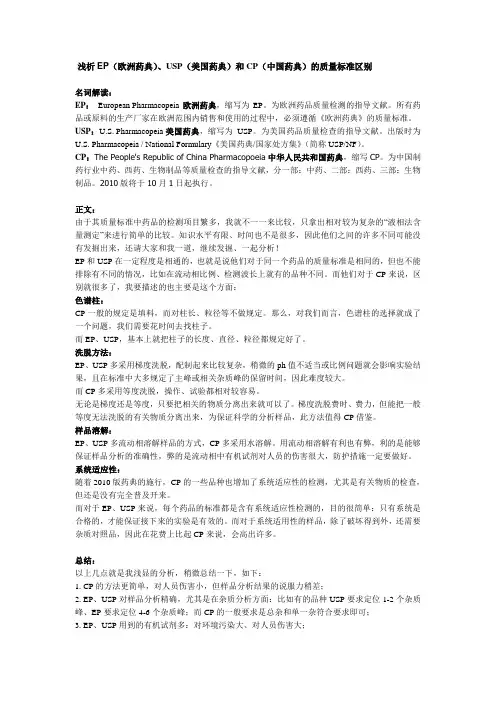
浅析EP(欧洲药典)、USP(美国药典)和CP(中国药典)的质量标准区别名词解读:EP: European Pharmacopeia欧洲药典,缩写为EP。
为欧洲药品质量检测的指导文献。
所有药品或原料的生产厂家在欧洲范围内销售和使用的过程中,必须遵循《欧洲药典》的质量标准。
USP:U.S. Pharmacopeia 美国药典,缩写为USP。
为美国药品质量检查的指导文献。
出版时为U.S. Pharmacopeia / National Formulary《美国药典/国家处方集》(简称USP/NF)。
CP:The People's Republic of China Pharmacopoeia中华人民共和国药典,缩写CP。
为中国制药行业中药、西药、生物制品等质量检查的指导文献,分一部:中药、二部:西药、三部:生物制品。
2010版将于10月1日起执行。
正文:由于其质量标准中药品的检测项目繁多,我就不一一来比较,只拿出相对较为复杂的“液相法含量测定”来进行简单的比较。
知识水平有限、时间也不是很多,因此他们之间的许多不同可能没有发掘出来,还请大家和我一道,继续发掘、一起分析!EP和USP在一定程度是相通的,也就是说他们对于同一个药品的质量标准是相同的,但也不能排除有不同的情况,比如在流动相比例、检测波长上就有的品种不同。
而他们对于CP来说,区别就很多了,我要描述的也主要是这个方面:色谱柱:CP一般的规定是填料,而对柱长、粒径等不做规定。
那么,对我们而言,色谱柱的选择就成了一个问题,我们需要花时间去找柱子。
而EP、USP,基本上就把柱子的长度、直径、粒径都规定好了。
洗脱方法:EP、USP多采用梯度洗脱,配制起来比较复杂,稍微的ph值不适当或比例问题就会影响实验结果,且在标准中大多规定了主峰或相关杂质峰的保留时间,因此难度较大。
而CP多采用等度洗脱,操作、试验都相对较容易。
无论是梯度还是等度,只要把相关的物质分离出来就可以了。
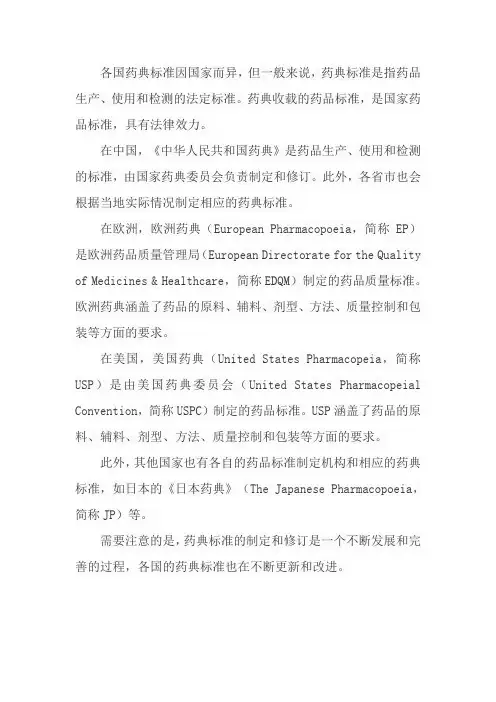
各国药典标准因国家而异,但一般来说,药典标准是指药品生产、使用和检测的法定标准。
药典收载的药品标准,是国家药品标准,具有法律效力。
在中国,《中华人民共和国药典》是药品生产、使用和检测的标准,由国家药典委员会负责制定和修订。
此外,各省市也会根据当地实际情况制定相应的药典标准。
在欧洲,欧洲药典(European Pharmacopoeia,简称EP)是欧洲药品质量管理局(European Directorate for the Quality of Medicines & Healthcare,简称EDQM)制定的药品质量标准。
欧洲药典涵盖了药品的原料、辅料、剂型、方法、质量控制和包装等方面的要求。
在美国,美国药典(United States Pharmacopeia,简称USP)是由美国药典委员会(United States Pharmacopeial Convention,简称USPC)制定的药品标准。
USP涵盖了药品的原料、辅料、剂型、方法、质量控制和包装等方面的要求。
此外,其他国家也有各自的药品标准制定机构和相应的药典标准,如日本的《日本药典》(The Japanese Pharmacopoeia,简称JP)等。
需要注意的是,药典标准的制定和修订是一个不断发展和完善的过程,各国的药典标准也在不断更新和改进。
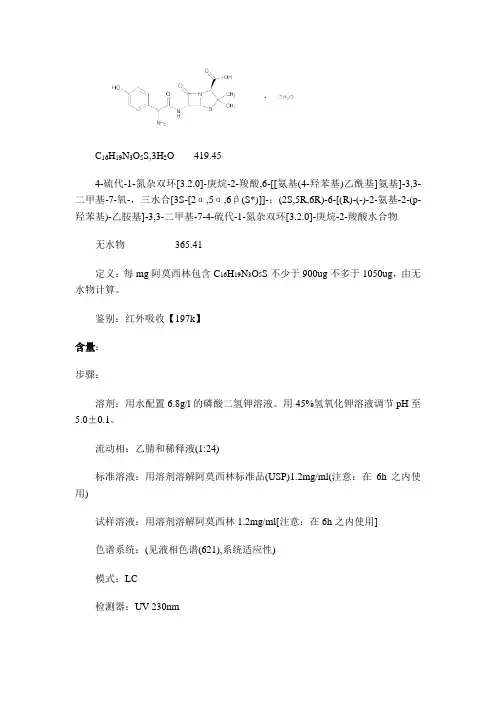
C16H19N3O5S,3H2O 419.454-硫代-1-氮杂双环[3.2.0]-庚烷-2-羧酸,6-[[氨基(4-羟苯基)乙酰基]氨基]-3,3-二甲基-7-氧-,三水合[3S-[2α,5α,6β(S*)]]-;(2S,5R,6R)-6-[(R)-(-)-2-氨基-2-(p-羟苯基)-乙胺基]-3,3-二甲基-7-4-硫代-1-氮杂双环[3.2.0]-庚烷-2-羧酸水合物无水物365.41定义:每mg阿莫西林包含C16H19N3O5S不少于900ug不多于1050ug,由无水物计算。
鉴别:红外吸收【197k】含量:步骤:溶剂:用水配置6.8g/l的磷酸二氢钾溶液。
用45%氢氧化钾溶液调节pH至5.0±0.1。
流动相:乙腈和稀释液(1:24)标准溶液:用溶剂溶解阿莫西林标准品(USP)1.2mg/ml(注意:在6h之内使用)试样溶液:用溶剂溶解阿莫西林1.2mg/ml[注意:在6h之内使用]色谱系统:(见液相色谱(621),系统适应性)模式:LC检测器:UV 230nm柱:4mm×25cm;填充物L1流速:1.5ml/min进样量:10ul系统适应性:样品:标准溶液适应性需求:拖尾因子:不大于2.5相对标准偏差:不大于2.0%分析:试样:标准溶液和样品溶液计算C16H19N3O5S,3H2含量ug/mg用以下公式结果=(ru/rs)×(Cs/Cu)×Pru=样品溶液中得出的峰面积rs=标准品中得出的峰面积Cs=标准品阿莫西林溶液的浓度Cu=样品溶液的浓度P=阿莫西林标准品的效价(ug/mg)验收标准:每mg无水化合物中900~1050ug C16H19N3O5S杂质:有机杂质:步骤:溶液A:2.72g/l磷酸二氢钾。
用1N氢氧化钾或20%磷酸调节pH到5.0±0.1溶液B:含磷的流动相:见下表梯度标准溶液:溶于溶液A中12.5ug/ml阿莫西林标准品系统适用性溶液:溶于溶液A中12.5ug/ml阿莫西林相关物质A和阿莫西林相关物质D样品溶液:用溶液A配置成1.25mg/ml阿莫西林[注意:在4°储存4h之内使用]色谱系统(见色谱,系统适应性)模式:LC检测器:UV 210nm柱:4.6mm×10cm;5um填充物L1柱温:40°流速:1.5ml/min进样量:10ul自动进样器温度:4°系统适应性:样品:标准溶液和系统适应性溶液适应性需求:[注意:在杂质表格1中通过相对保留时间鉴别峰]分辨率:在阿莫西林相关物质A和阿莫西林相关物质D第二峰不少于1.5系统适应性溶液相对标准偏差:不多于标准物质的10%分析:样品:标准溶液和样品溶液计算阿莫西林每一种样品含量的百分率:结果=(ru/rs)×(Cs/Cu) ×F×100ru=从样品溶液中或的的每一个杂质峰rs=从标准溶液中获得的阿莫西林峰Cs=阿莫西林标准品的浓度Cu=阿莫西林样品溶液标示浓度F=单位转换因素(0.001mg/ug)验收标准:[注意:限制是阿莫西林标准溶液吸收峰的0.03%]单杂质:见杂质表1总杂质:不多于5%杂质表1a (R)-2-氨基-2-(4-羟苯基)乙酸b色谱系统区分了两种青霉噻唑酸c(4S)-2-{[(R)-2-氨基-2-(4-羟苯基)乙酰胺基](羧基)甲基}-5,5-二甲基四氢噻唑-4-羧酸d (2S,5R,6R)-6-氨基-3,3-二甲基-7-氧-4-硫代-1-氮杂双环[3.2.0]-庚烷-2-羧酸e列出的化合物仅仅是用作信息不用来报导f(2S,5R,6R)-6-[(S)-2氨基-2-(4-羟苯基)乙酰胺基]-3,3-二甲基-7-氧-4-硫代-1-氮杂双环[3.2.0]-庚烷-2-羧酸g(2S,5R,6R)-6-{(R)-2-[(R)-2-氨基-2-(4-羟苯基)乙酰胺基]-2-(4-羟苯基)乙酰胺基}-3,3-二甲基-7-氧-4-硫代-1-氮杂双环[3.2.0]-庚烷-2-羧酸h色谱系统区分了两种青霉噻唑酸i (4S)-2-{[(R)-2-氨基-2-(4-羟苯基)乙酰胺基]甲基}-5,5-二甲基四氢噻唑-4-羧酸j(2S,5R,6R)-6-(2-[(R)-2-氨基-2-(4-羟苯基)乙酰胺基]-2-((4S)-4-羧基-5,5-二甲基四氢噻唑-2-卤代)乙酰胺基)-3,3-二甲基-7-氧-4-硫代-1-氮杂双环[3.2.0]-庚烷-2-羧酸k 3-(4-羟苯基)对二氮杂苯-2-羟基l (4S)-2-[5-(4-羟苯基)-3,6-二氧哌嗪-2-卤代]-5,5-二甲基四氢噻唑-4-羧酸m(2S,5R,6R)-6-((2R)-2-{2-[(R)-2-氨基-2-(4-羟苯基)乙酰胺基]-2-[(4S)-4羧基-5,5-二甲基四氢噻唑-2-卤代]乙酰胺基}-2-(4-羟苯基)乙酰胺基)-3,3-二甲基-7-氧-4-硫代-1-氮杂双环[3.2.0]-庚烷-2-羧酸n(2S,5R,6R)-6-{(2S,5R,6R)-6-[(R)-2-氨基-2-(4-羟苯基)乙酰胺基]-3,3-二甲基-7-氧-4-硫代-1-氮杂双环[3.2.0] 庚烷-2-羧氨基}-3,3-二甲基-7-氧-4-硫代-1-氮杂双环[3.2.0]-庚烷-2-羧酸。
外国药典药典标准的重要性在于保证药品质量,世界上许多国家都制定有自己的法定国家药品标准,而药典是重要的国家药品标准形式。
其中影响较大的是《美国药典/ 国家处方集》(USP/NF)、《英国药典》(BP)、日本药局方(JP)。
(一)美国药典《美国药典/国家处方集》(U.S.Pharmacopeia / National Formulary,USP/NF)由美国政府所属的美国药典委员会编辑出版。
USP 于1820年出第一版,1950年以后每5年出一次修订版。
NF 于1883年出第一版,1980年第15 版起并入USP,但仍分两部分,前面为USP,后面为NF。
对于在美国制造和销售的药物和相关产品而言,USP/NF 是唯一由美国食品药品监督管理局(Food and Drug Administration,FDA)强制执行的法定标准。
美国药典现为USP42-NF37,于2019年5月1日生效。
(二)英国药典《英国药典》(British Pharmacopoeia,BP)由英国药品与医疗保健产品监管局(Medicines and Healthcare Products Regulatory Agency,MHRA)英国药典委员会秘书处制定出版。
它是英国药品制剂和药用物质的官方标准文集。
英国药典是药品生产、供应、使用、检验和管理部门共同遵循的法定技术标准。
英国药典更新周期为1 次/年。
现为BP2020,于2020年1月1日生效,共6 卷。
(三)日本药典《日本药典》(The Japanese Pharmacopoeia,JP),又名《日本药局方》,由日本药局方编辑委员会编纂,日本厚生省颁布执行。
它分两部出版,第一部收载原料药及其基础制剂,第二部主要收载生药、家庭药制剂和制剂原料。
《日本药局方》现为第17 修正版,于2016年4月1日生效。
硫酸软骨素钠质量标准(USP)硫酸软骨素钠是从牛、猪、鸟类等家畜软骨组织中提取制得的硫酸化链状黏多糖钠盐。
主要为N—乙酰半乳糖胺(2-乙酰胺—2脱氧—β—D—吡喃半乳糖)和D—葡萄糖全算的共聚物的硫酸酯的钠盐,共聚物内己糖通过β—1,4及β—1,3糖苷键交替连接。
在普通使用的黏多糖中,硫酸基主要位于分子中半乳糖的4位上,少量的硫酸基在6位上。
在普遍使用的黏多糖中软骨糖胺部分主要为4—位单硫酸盐,少量为6-位。
按干燥品计算,含硫酸软骨素钠90。
0%~105.0%。
注意:硫酸软骨素钠具有很强的引湿性,应避免暴露于空气中,称量应迅速。
包装、贮存:保存于密封容器。
【溶液澄清度和颜色】取本品2.5g至50ml容量瓶中。
溶于不含二氧化碳的纯水中,并稀释至刻度,摇匀后立即检查.置于1cm吸收池内,在420nm波长处检测吸光度,以不含二氧化碳的水作为对照:吸光度不得大于0。
35。
【鉴别】A。
本品的红外光吸收图谱应与硫酸软骨素钠对照品的图谱一致。
B。
取本品0。
5g溶于10ml纯水中,显钠盐的鉴别反应。
【比旋度】取本品,精密称定,用水溶解并定量稀释制成每1ml中约含30mg的溶液。
测定,比旋度应为-20°至-30°.【微生物限度】细菌总数不能超过1000 CFU/g,霉菌和酵母菌总数不能超过1000 CFU/g,在相同条件下不得检出沙门氏菌和大肠杆菌。
【pH】取本品0。
1g溶于10ml纯水中溶解,pH值为5.5~7。
5。
【干燥失重】取本品,在105℃干燥4小时,减失重量不得过10。
0%。
(注意:硫酸软骨素钠有很强的吸湿性,应避免暴露于空气中,称量应迅速。
)【炽灼残渣】以干燥品计算,遗留残渣应为20。
0%~30。
0%。
【氯化物】取本品0.10g,与0.7ml 盐酸(浓度0.020 mol/L)对照液比较,不得更深(0。
5%)。
【硫酸盐】取本品200mg溶于40ml水中,加入10ml(30mg/ml)西吡氯胺溶液,混匀,过滤。
Sertraline Hydrochloride(ser' tra leen hye'' droe klor' ide).C 17H 17Cl 2N ·HCl 342.691-Naphthalenamine, 4-(3,4-dichlorophenyl)-1,2,3,4-tetrahydro-N -methyl-, hydrochloride, (1S -cis ); (1S ,4S )-4-(3,4-Dichlorophenyl)-1,2,3,4-tetrahydro-N -methyl-1-naphthylamine hydrochloride [79559-97-0].DEFINITIONSertraline Hydrochloride contains NLT 97.0% and NMT 102.0% of C 17H 17Cl 2N ·HCl, calculated on the anhydrous basis.IDENTIFICATION• A. I NFRARED A BSORPTION 197M• B. The retention time of the major peak of the Sample solution corresponds to that of sertralinehydrochloride from the System suitability solution , as obtained in the test for Limit of (R,R) sertraline hydrochloride .• C. I DENTIFICATION T ESTS —G ENERAL , Chloride 191: Meets the requirementsSample solution: A solution (1 in 10) in a mixture of alcohol and water (1:1)ASSAY• P ROCEDUREBuffer: 5.75 g/L of monobasic ammonium phosphate in water. Adjust with phosphoric acid to a pH4.2.Mobile phase: Methanol and Buffer (12:13)Standard solution: 0.04 mg/mL of USP Sertraline Hydrochloride RS in Mobile phaseSample solution: 0.04 mg/mL of Sertraline Hydrochloride in Mobile phaseChromatographic system(See Chromatography 621, System Suitability .)Mode: LCDetector: UV 220 nmColumn: 4.0-mm × 25-cm; 5-µm packing L45Column temperature: 30Flow rate: 1 mL/minInjection size: 20 µLSystem suitabilitySample: Standard solutionSuitability requirementsTailing factor: NMT 1.3Relative standard deviation: NMT 2.0%AnalysisSamples: Standard solution and Sample solutionCalculate the percentage of C 17H 17Cl 2N ·HCl in the portion of Sertraline Hydrochloride taken:Result = (r U /r S ) × (C S /C U) × 100 Acceptance criteria: 97.0%–102.0% on the anydrous basisIMPURITIESInorganic Impurities• R ESIDUE ON I GNITION 281: NMT 0.3%• H EAVY M ETALS , Method II 231: 30 ppmSPECIFIC TESTS• W ATER D ETERMINATION , Method Ia 921: NMT 0.50%• L IMIT OF (R,R ) S ERTRALINE H YDROCHLORIDEMobile phase: Hexane, 2-propanol, and diethylamine (960:40:1.5)System suitability solution: Transfer 10 mg of USP Sertraline Hydrochloride Racemic Mixture RS into a 20-mL volumetric flask. Add 4 mL of diluted ammonia water (1 in 10) and 10 mL of hexane. Shake well until the organic phase is clear. Wait for phase separation, transfer about 2.0 mL from the top layer into a 20-mL volumetric flask, and dilute with hexane to volume.Standard solution: Transfer 10 mg of USP Sertraline Hydrochloride RS into a 20-mL volumetric flask. Add 4 mL of diluted ammonia water (1 in 10) and 10 mL of hexane. Shake well until the organic phase is clear. Wait for phase separation, transfer 1.0 mL from the top layer into a 10-mL volumetric flask, and dilute with hexane to volume. Further dilute quantitatively and stepwise, if necessary, to obtain a solution having a known concentration of 0.01 mg/mL.Sample solution: Transfer 20 mg of Sertraline Hydrochloride to a 20-mL volumetric flask. Add 4 mL of diluted ammonia water (1 in 10) and 10 mL of hexane. Shake well until the organic phase is clear. Wait for phase separation, and use the top layer.Chromatographic system(See Chromatography 621, System Suitability .)Mode: LCDetector: UV 235 nmColumn: 4.6-mm × 25-cm; 5-µm packing L51Column temperature: 5Flow rate: 1 mL/minInjection size: 20 µLr U== peak response from the Sample solution r S== peak response from the Standard solution C S== concentration of USP Sertraline Hydrochloride RS in the Standard solution (mg/mL)C U == concentration of Sertraline Hydrochloride inthe Sample solution (mg/mL)System suitabilitySample: System suitability solution[N OTE —The relative retention times for (R,R ) sertraline hydrochloride and sertraline hydrochloride are about 1.16 and 1.0, respectively. ]Suitability requirementsResolution: NLT 2.8 between sertraline hydrochloride and (R,R ) sertraline hydrochloride Relative standard deviation: NMT 10.0%AnalysisSamples: Standard solution and Sample solutionCalculate the percentage of (R,R ) sertraline hydrochloride in the portion of Sertraline Hydrochloride taken:Result = (r U /r S ) × (C S /C U) × 100 Acceptance criteria: NMT 1.5%ADDITIONAL REQUIREMENTS• P ACKAGING AND S TORAGE : Preserve in tight, light-resistant containers at a temperature not exceeding40.• USP R EFERENCE S TANDARDS 11USP Sertraline Hydrochloride RSUSP S ERTRALINE H YDROCHLORIDE R ACEMIC M IXTURE RS(1RS ,4RS )-4-(3,4-Dichlorophenyl)-N -methyl-1,2,3,4-tetrahydro-1-naphthylamine hydrochloride. C 17H 17Cl 2N ·HCl 342.69Auxiliary Information — Please check for your question in the FAQs before contacting USP. USP34–NF29 Page 4218Pharmacopeial Forum : Volume No. 34(5) Page 1189Chromatographic Column — SERTRALINE HYDROCHLORIDEChromatographic columns text is not derived from, and not part of, USP 34 or NF 29. r U== peak response for (R,R ) sertraline hydrochloride from the Sample solution r S== peak response for Sertraline Hydrochloride from the Standard solution C S== concentration of USP Sertraline Hydrochloride RS in the Standard solution (mg/mL)C U == concentration of Sertraline Hydrochloride inthe Sample solution (mg/mL)。
美国药典USP浓度重量克分子浓度、容量克分子浓度和当量浓度用于本药典内大部分化学含量测定和检测方法中(亦见容量溶液于试剂、指示剂和溶液篇章中)重量克分子浓度用m表示,前面有一个数目字即为该溶质的克分子数(1公斤的所标明的溶液中)容量克分子浓度用M表示,前面的数目字表示在制备1立升溶液中所含的该溶质的克分子数当量浓度用N表示,前面的数目字表示制备1立升溶液中该溶质的克当量数。
百分比计量—百分比浓度如下表示:重量于重量百分比—(w/w)表示一个组分在100克溶液或混合物中的克数重量于容量百分比—(w/v)表示一个组分在100毫升溶液中的毫升数(不管溶剂是水还是其他液体)容量于容量百分比—(v/v)表示一个组分在100毫升溶液中的毫升数用百分比这个名词没有限定意义,对固体和半固体用w/w;对溶液或固体在溶液中的悬浮液用w/v;对液体在液体溶液用v/v;气体在液体内用w/v,例:一个1%的溶液是由溶解1克固体或半固体或1毫升溶液于足够的溶剂使成100毫升溶液。
由于室温的差异,微小的容量计量差异可忽略。
有效数据和允许偏差此处表示的数限是上限和下限并包括此二值以及其间的所有数字,但在限度以外的数值不在内。
在供试品的专篇内,检测中不管数字是以百分比还是绝对数字来表示都是表示最末的数字。
在容量滴定法中相当的叙述——容量滴定法故采用包括相当于标化滴定液的每毫升相当于供试品的重量,在这样的相当陈述,滴定液的浓度中的有效数字被认为相当于供试品的重量有效数字,所有的容量滴定应做空白校正。
允许偏差—药典所述的供试品的专篇内所规定的那些限度的建立是把供试品作为药物来使用或作为营养剂、饮食补充剂使用,除非另有其他指定。
药物的活性成分用分子式来计其强度标明了化学本质,如同已给的供试品的化学全名其绝对纯度为100%。
中略。
一个可写在检测报告上的值通常是几个单独测定值的合计,此结果是按规定所做的一个完整的测定所得而用于可接受的标示值进行比较,当需舍入时,5以下舍去,5(包含5)以上进1,如:标准含量为≥98.0% 实测值舍入前97.95% 舍入后98.0% 判断合格舍入前97.94% 舍入后97.9% 判断不合格标准限度≤0.02% 实测值舍入前0.025% 舍入后0.03% 判断不合格舍入前0.015% 舍入后0.02% 判断合格舍入前0.024% 舍入后0.02% 判断合格检测和含量测定设施——在检测或含量测定中所用的容器或设施的大小型式不过是一种推荐。